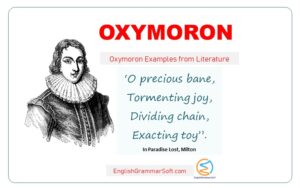Types of Paradox in Literature
Paradox Definition A self-conflicting statement which at first appears to be confusing but later-on it became latent truth. It is often used to make the…

Paradox Definition A self-conflicting statement which at first appears to be confusing but later-on it became latent truth. It is often used to make the…

History and Etymology of Oxymoron: It was first known use in 1657. Late Greek oxymōron, from neuter of oxymōros pointedly foolish, from Greek oxys sharp,…

Irony Definitions a. There is a contrast between what is said and what is meant, or between appearance and reality. b. A mode of discourse…

Metonymy A metonymy is a figure of speech. It derived via Latin from Greek metonymia (from meta-, meaning “among,” with, or after, and onyma, meaning…

Pun Figure of Speech Pun It was first known use in 1644. Definition A joke based on the interplay of homophones, words with the same…

What is Synecdoche? Synecdoche is a figure of speech in which the whole represents just one part. This can be done with personification and metaphor…

Euphemism Figure of Speech (Definition, Examples and Types) History and Etymology: It was first known use in 1681. Greek work derived from euphemismos, from euphemos…

Epigram It was first known use in 15th Century. Etymology of epigram Middle English epigrame, from Latin epigrammat-, epigramma, from Greek, from epigraphein to write…

Today, you will learn about Antithesis, History of Antithesis Antithesis Definitions Explanation of Antithesis Antithesis Examples Antithesis Examples in Literature Tips on Using Antithesis in…

Alliteration Definition and Examples in Literature In this article, we are going to discuss these points. Definition Alliteration is a literary technique when two or…